French Horn Introduction
Share

Horn
The horn is a brass instrument whose soft resonant timbre allows it to harmonize well with both brass and woodwind instruments. One of the unique aspects of this instrument is that the player keeps a hand in the bell while playing.
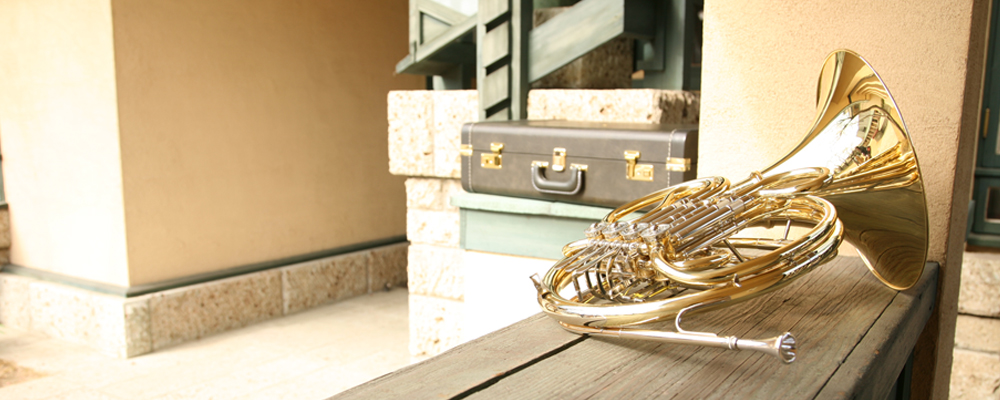
The origins of the Horn
The birth of the horn
In the beginning was an animal's horn
The original horn was simply an animal horn. The word for "horn" in German is "horn," in French "cor," and in Italian "corno." The terms "cor" and "corno" originally meant an animal's horn, directly expressing the animal origins of the horn. It is most likely that people from ancient times turned the horns of their prey into musical instruments. This description both explains the origin of the horn and the etymology of the word "horn." There are many other musical instruments that bear the name "horn," but today, the instrument known as the horn is commonly called the "French horn".
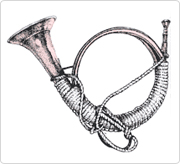
A very simple structure, until the mid-nineteenth century
Until the middle of the sixteenth century, the horn was used by hunters as a means of communication during the hunt, and thus the body of the horn was wound in large coils so that it could be carried on the shoulder and sounded while riding a horse. In addition, the bell faced to the rear to keep it from getting in the rider's way.
The horn is very similar to the trumpet in that sound is produced through the vibration of the lips. Maybe that is why the horn has a history of development almost identical to that of the trumpet.
Horns made up to the middle of the nineteenth century are called "natural horns" because of their simplistic structure, which consists of a large bell, a single coiled tube, and a mouthpiece.
The pitch of this type of instrument can only be changed by changing the vibration of the lips, and even then it is only possible to produce a tone referred to as a "natural harmonic." This of course means that it cannot play musical scales. This state of affairs drove the players of the horn to think of sticking a hand in the bell to produce a tone other than this natural harmonic. This way of playing the horn, called the "hand-stopping technique" developed among horn players in the eighteenth century.
Despite the new hand-stopping technique, the range of tones possible with the horn was still very limited, the tones and pitches were unstable, and the timbre had a muffled quality. The resolution of this problem came in the mid-nineteenth century with the development of what was known then as the "valve horn," a horn whose effective length could be altered instantly by opening one or more valves like those on today's modern instruments.
With the arrival the valve horn, horn players could now easily play a stable chromatic scale.
The end of the nineteenth century saw the invention of the double horn, which combined two tubes of different lengths, and in the twentieth century, the triple horn was invented.
The origins of the Horn
The modern horn
The allure of the horn
The horn is a mid-range brass instrument that has the widest tonal range of all brass instruments. The extremely rich, soft timbre gives it a special quality half-way between brass and woodwinds, and in harmonies, it blends well with the timbres of many other instruments. It is also one of the more expressive instruments, able to create a mysterious aura as well as a buoyant or violent mood. This cornucopia of timbres and variety of expression is the essence of the horn's allure. Being able to alter the tone and fine-tune the pitch by putting a hand in the bell is one of the more distinctive traits of the horn.
The horn family
The F single horn
This is the F single horn, or F horn. The basic pitch of the F horn has a unique, beautiful timbre.
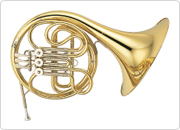
YHR-314 II
The B♭ single horn
This is the B♭ single horn, or B♭horn. The pitch of the B♭horn is four steps higher than the F horn, and so this horn has a brighter, clarion tone. Horn music is written in the key of F, and so transposition is necessary when playing the B♭horn.
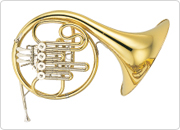
YHR-322 II
The F/B♭full-double horn
The F/B♭full-double horn, the most common and widely used horn today, can produce both F and B♭notes from a single instrument, and can produce both F and B♭ timbre.
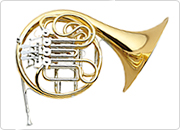
YHR-567
F/B♭ semi-double horn
The F/B♭semi-double horn consists of a B♭tube and a supplementary F tube, and as a result it is lighter than the full-double horn.

YHR-841GD
The B♭- High F descant double horn
The B♭- High F descant double horn has the same structure as a full-double horn, but instead of a standard F tube, it has a half-length high-F tube that allows this instrument to perform in a higher tonal range.

YHR-881
The triple horn
The triple horn is really a full-double horn with a high-F tube for playing in the higher ranges, and though the overall tonal range is unchanged, it is more stable in the higher range. The B♭tube is the primary tube, with the player switching to the other tubes as necessary.

How to Play the Horn
The biggest mystery of the horn-putting the right hand in the bell
Changing the pitch with the right hand
In contrast to the modern horn, the natural horn originally had no bell, and the only way to change the pitch was by changing the speed with which air was blown into the instrument. As a result, the notes that were emitted were limited to natural harmonics. C, G, C, E, G, B♭-horn players jumped around this arrangement of notes, and they could not play a phrase that included D or F. What changed all that was the hand-stopping technique.
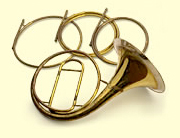
A natural horn-which only produces natural harmonics-and crooks, which are replacement pipes to change the pitch

Natural harmonics of brass instruments
The hand-stopping technique was devised as a solution to playing notes that were not natural harmonics. Hand-stopping entails controlling the pitch by inserting the right hand into the bell in varying degrees. This technique includes the full-stop and the half-stop, and it was made popular by Bohemian horn player A. J. Hampel in the mid-eighteenth century. Hand-stopping can change a note by a semitone or whole tone up or down, and thus makes it possible to play chromatic music on a natural horn.

Is hand-stopping just a relic from the past?
Hand-stopping is no longer necessary to produce semitones because the horn has valves now. However, hand-stopping is still used today to support the instrument and to make minor adjustments to the pitch or timbre.
For example, playing the F horn slightly stopped with the right hand produces a tone called half-mute: a muddled, warm timbre that is a semitone lower than the note on the music.
